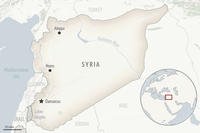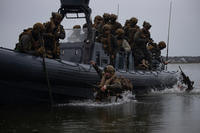The opinions expressed in this op-ed are those of the author and do not necessarily reflect the views of Military.com.
Peter W. Singer is a strategist at New America and founder and managing partner at Useful Fiction LLC.
Balloons aren't going to decide whether we win or lose a war with China.
Given the heated discussion of Chinese balloons everywhere from the pages of this publication to the halls of Congress, I know it is hard to believe. Indeed, we've been told by multiple leaders and media outlets that this is a "new Sputnik moment" for America.
So why would I think that? The reason is that at literally the same moment last week that hundreds of members of Congress gathered to learn the latest intelligence on China's wayward balloons and hector the Biden team for failing to foil the fabric threat, I was at a sparsely attended House Armed Services Committee hearing a few hallways down that explored the actual question that matters for our security.
The hearing, entitled "The Future of War: Is the Pentagon Prepared to Deter and Defeat America's Adversaries?" was chaired by Rep. Mike Gallagher, R-Wis., who is also chairman of the new Select Committee on China. As one of the expert witnesses asked to testify, I found notable not just the collegial manner in which Gallagher and his Democrat counterpart, Ranking Member Ro Khanna of California, treated each other (Gallagher even gave Khanna a birthday present to pass on to his wife), but the welcome substance of the discussion. And, illustratively, at no point in the hours of debate on whether our military would be ready to fend off America's foes did its lack of either balloon-building or balloon-popping technology come up.
Instead, the discussion focused on what actual elements and reforms would enable us to win future wars. Even more specifically, it focused on how we could solve the central problem for U.S. defense planning: deterring China from even starting a war. (To be clear, it is not by it launching balloons, but by attacking Taiwan.)
Given China's tremendous growth in power, it is as tough a problem as they come. Yet, fortunately, the testimony identified 20 areas of action:
- Enact regular open-ended wargames, designed to test and learn about key changes in warfare.
- Avoid letting political and bureaucratic inertia and the mentality of "sunk costs" drive our next weapons acquisitions; what we've bought in the past shouldn't determine what we buy next.
- Foster a dynamic defense marketplace, where the military can more easily purchase from both big and small firms.
- Scale the successful innovation hubs and experimental task forces present in a few units, such that every command has rapid means of learning and implementation.
- Acquire a new generation of unmanned systems, but avoid drones that simply replicate the expensive manned systems they are replacing.
- Develop new doctrines to take advantage of robotics' unique attributes, allowing swarming and cheap, high-risk uses.
- Prepare for our adversary's certain use of drone swarms, in turn, by acquiring new counter-drone systems.
- Invest in artificial intelligenceI to match its growing civilian importance.
- Reform U.S. military networks to copy the civilian world's best practice of a federated model of meshed data, to better take advantage of AI's possibilities.
- Ensure the U.S. military is able to retain its professionalism, while still evolving to reflect the new American society it both draws upon and protects.
- Build upon new designs being tested in the Army and Marine Corps for a new generation of military units that can operate across domains and rapidly deploy out into networks of small teams, each able to fight independently yet generate disproportionate effects.
- Transform special operations forces into blended teams of technical experts and elite soldiers, able to provide a "full continuum" of uses against not just terrorists and insurgents, but great power militaries.
- Create redundancies and scale in our space networks through fleets of small satellites that are cheap so you can have hundreds or even thousands instead of a handful of big ones systems.
- Bake cybersecurity into the emerging Internet of Things through greater design requirements and market regulation, to limit physical damage from digital threats.
- Utilize both cyber and diplomatic means to out covert campaigns meant to undermine democracies and create digital literacy programs, modeled after successful allied efforts, to better equip American youth and our forces for new online threats.
- Engage in persistent competition on the information, economic, political and cyber fronts, to create greater friction along China's "Belt and Road" and foster its own imperial overstretch challenges.
- Provide Taiwan with distributed anti-air weapons and unmanned systems and, most especially, cheap, rapidly deployable smart sea mines to block essential seaways.
- Aid efforts to create a Taiwanese society prepared for resistance, especially in urban settings, and mirror its digital governance systems outside the country.
- Bolster multilateral ties between states that have worsening bilateral ties with China.
- Secure Russia's defeat in Ukraine, both to weaken it and its allies, as well as to provide a model of success for other democracies under threat.
The bad news may be that none of these steps to winning the future is as exciting as a balloon. But the good news is none of them needs an imagined "Sputnik moment" to come true. Doing better at deterring and defeating America's adversaries just requires us to focus instead on the important stuff.















